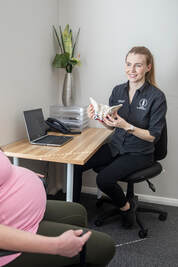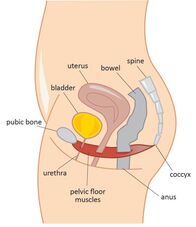Women's Health Services
|
Physio Jess has completed her level 1 training in both the Women’s Pelvic Health, and Women’s Health through the Life Stages courses provided by the Australian Physiotherapy Association, as well as many short professional development courses in this field. She feels passionate about supporting women of all ages live a happy and healthy lifestyle.
|
Pregnancy (from planning to postnatal)
Pregnancy, childbirth and caring for young children all place significant demands on our bodies. While some things may be common, it doesn’t mean they are normal or that you have to suffer through them.
Working with a physiotherapist when you are planning a pregnancy can help to minimise issues in the coming months.
Working with a physiotherapist when you are planning a pregnancy can help to minimise issues in the coming months.
|
Common symptoms experienced during pregnancy can include:
Many of the aches and pains of pregnancy are due to the change in demands on our muscles and joints, particularly as the center of gravity changes as the baby grows. Addressing muscle imbalances through a combination of hands on therapy and strengthening and stretching exercises can reduce many of the symptoms. Our physiotherapists can help with hands on therapy, education/advice, exercises and physical supports such as lumbar and sacroiliac braces. |
|
Recovery after birth has many factors needing consideration to restore you to
physical and emotional strength. Our Physio Jess can assess and help you with:
|
Jess can assess and advise you on safe and gentle exercises to help strengthen, support and prevent issues from repetitive activities such as feeding, rocking, changing nappies and lifting. She can provide advice and treatment for breast inflammation and support women in their breastfeeding journeys. Jess can also advise and guide you in helping to safely return your pre pregnancy strength and fitness levels or goals.
The Pelvic Floor and Continence
One in three women who have had children (regardless of delivery method) experience continence issues at some stage in their lives. The condition can also occur in young women, or in older women who have never had children.
While many women manage an occasional leak with pads, women with more severe symptoms can suffer a lack of confidence to go out socially, as well as to do daily tasks such as food shopping. Physiotherapy can in many cases eliminate the problem, and in others reduce symptoms and reliance on continence aids.
Our physio Jess can assess and manage pelvic floor problems, including different types of urinary continence, and work with you to restore your confidence and quality of life.
Note: Faecal continence issues or male continence issues can be addressed through your GP, specialist pelvic floor physiotherapists, or by contacting the Continence Foundation of Australia.
While many women manage an occasional leak with pads, women with more severe symptoms can suffer a lack of confidence to go out socially, as well as to do daily tasks such as food shopping. Physiotherapy can in many cases eliminate the problem, and in others reduce symptoms and reliance on continence aids.
Our physio Jess can assess and manage pelvic floor problems, including different types of urinary continence, and work with you to restore your confidence and quality of life.
Note: Faecal continence issues or male continence issues can be addressed through your GP, specialist pelvic floor physiotherapists, or by contacting the Continence Foundation of Australia.
|
Symptoms which may indicate a pelvic floor/continence issue:
|
|
What is the pelvic floor and how does it affect continence?
The pelvic floor is a group of muscles which span the base of the pelvis between the coccyx at the back, the pubic bone at the front, and the sitting bones at the sides. There are openings for the urethra, vagina and anus. The pelvic floor muscles help to support the pelvic organs, including the uterus, bladder and bowel. The muscles are also responsible for ensuring control of the opening/closing of the urethra and anus, thus controlling continence. For further information about the muscles and their function, please visit the website of the Continence Foundation of Australia. |
What does physiotherapy involve?
At your first visit, a thorough history will be taken, including details of your symptoms, pregnancies and other health issues. Jess will explain the pelvic floor in more detail, and you will then be asked to complete a diary of symptoms for three days, including fluid intake, volumes of urine passed, and any leakages. This is an essential part of management as it can help identify the problem, as well as provide a basis for guidance on fluid intake etc.
Treatment for your condition may include any of the following:
At your first visit, a thorough history will be taken, including details of your symptoms, pregnancies and other health issues. Jess will explain the pelvic floor in more detail, and you will then be asked to complete a diary of symptoms for three days, including fluid intake, volumes of urine passed, and any leakages. This is an essential part of management as it can help identify the problem, as well as provide a basis for guidance on fluid intake etc.
Treatment for your condition may include any of the following:
- Lifestyle advice including diet, fluids, posture and weight loss
- Exercises and activities to avoid in the short or long term
- Pelvic floor specific exercises – tailored to your individual problem
- Completion of a symptom diary over an extended period
- Reassessment after several weeks to monitor progress
- Discussion of how your other health issues may impact on your problem
- Referral to a specialist pelvic floor physiotherapist or via your GP to a medical specialist
If you have a pelvic floor problem, there are certain exercises which may exacerbate your symptoms. For this reason, we would recommend you discuss your issues with Jess prior to starting/changing an exercise program, or if you have developed any symptoms after starting a new program.
Download your guide to what Women's Health check's you need and when:
| Women's Health Checks - your guide to what you need and when | |
| File Size: | 2241 kb |
| File Type: | |





